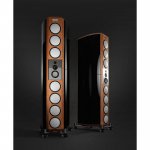Actually, I think I'll go with six C220s. It might seem insane, but this way, the mid bass also comes close to being room-high. To continue the concept of the singular big wave evenly spreader across the room. Though, what do you think? Should I bend the baffle so the mid woofers will all be aimed straight to the position of the ears, like The Gryphon does with their Kodo system. Though the mid bass frequencies are largely omnidirectional, this will somewhat concentrate all energy to the position of the ears and make the waves of each individual mid woofer arrive at the same time, though, it doesn't cary the concept of making one big flat wave traveling through the room. So, or should I keep the baffle flat to cary through the concept of developing one big flat wave traveling through the room? I do like this idea but might actually be harder to accomplish by mid woofers placed in the room, instead of in the wall like with the subwoofers.
I don't think using multiple small woofers is a good idea. It'll be more expensive and you'll be pushing them below their working range. Woofers start behaving very different below their resonance.
You can force a drivers frequency response quite far, but it does have it's consequences.
Personally I think 1-2 good 10-12" subs per channel will be plenty. Though my needs are different from yours, also my wallet looks different.
If you truly want the lowest distortion, I think motional feedback is the way to go.
RMS Acoustics has published very useful papers on that.
Do you have a source for the scanspeak woofers distortion?
You can force a drivers frequency response quite far, but it does have it's consequences.
Personally I think 1-2 good 10-12" subs per channel will be plenty. Though my needs are different from yours, also my wallet looks different.
If you truly want the lowest distortion, I think motional feedback is the way to go.
RMS Acoustics has published very useful papers on that.
Do you have a source for the scanspeak woofers distortion?
I know one or two good subs usually is plenty, but it's not about the number of subs, it's about creating a room-high line source. To achieve a line source creating on big flat wave, I must have a row of woofers over the entire height of the room.
Measurements of the 32W are available at AudioXpress. Test Bench: Scan-Speak 32W/4878T00 Subwoofer | audioXpress
Measurements of the 32W are available at AudioXpress. Test Bench: Scan-Speak 32W/4878T00 Subwoofer | audioXpress
Here are the 3D models. Might I ever build something like this I would probably work a little more on the styling but it's about the concept for now.
The mid-high towers will consist from 3 compartments, with the mid bass in separate enclosures, decoupled. It's quite would probably be made from solid aluminum. The bass towers with the 32Ws in the corners, six on modules in this case. This should be epic if I were to ever build it.
The mid-high towers will consist from 3 compartments, with the mid bass in separate enclosures, decoupled. It's quite would probably be made from solid aluminum. The bass towers with the 32Ws in the corners, six on modules in this case. This should be epic if I were to ever build it.
Attachments
-
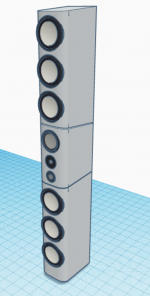 Schermafbeelding 2019-03-21 om 11.48.09.png657.2 KB · Views: 264
Schermafbeelding 2019-03-21 om 11.48.09.png657.2 KB · Views: 264 -
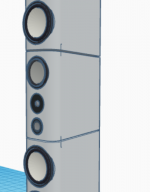 Schermafbeelding 2019-03-21 om 11.48.20.png132.5 KB · Views: 261
Schermafbeelding 2019-03-21 om 11.48.20.png132.5 KB · Views: 261 -
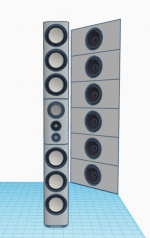 Schermafbeelding 2019-03-21 om 11.48.42.png570.4 KB · Views: 262
Schermafbeelding 2019-03-21 om 11.48.42.png570.4 KB · Views: 262 -
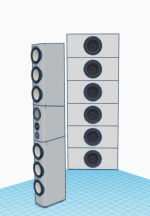 Schermafbeelding 2019-03-21 om 11.49.39.png557.8 KB · Views: 255
Schermafbeelding 2019-03-21 om 11.49.39.png557.8 KB · Views: 255 -
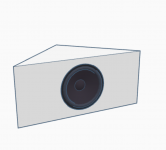 Schermafbeelding 2019-03-21 om 11.49.22.png87.1 KB · Views: 259
Schermafbeelding 2019-03-21 om 11.49.22.png87.1 KB · Views: 259 -
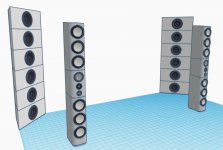 Schermafbeelding 2019-03-21 om 11.56.01.jpg151.7 KB · Views: 55
Schermafbeelding 2019-03-21 om 11.56.01.jpg151.7 KB · Views: 55 -
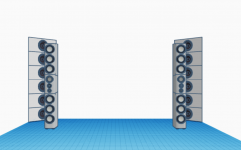 Schermafbeelding 2019-03-21 om 11.50.03.png473 KB · Views: 68
Schermafbeelding 2019-03-21 om 11.50.03.png473 KB · Views: 68
Last edited:
Definitely took some inspiration from those! I also took some inspiration from the The Gryphon Trident II and Kodo, Göbel Epoque Aeon Reference, a bit of the RaidhoTD 4.8, Teilaktiver DIVERSO, Myro Time. Really speakers with many (mid) woofers on a row in a relatively slender cabinet, since these C220s in a sealed box really don't need that much space at all.
By the way. The mid bass cabinets are decoupled and all but I would still like to minimize vibrations. The cabinets will probably be made of aluminum were I ever to actually build this, but I do like the idea of vibration cancelling by placing more woofers in opposite directions. I could do this but this would mean mounting mid woofers on the back of the cabinets. Will this cause time issues, even though bass is largely omnidirectional? Or maybe, would side mounting the woofers be a option? This will eliminate the distance difference in depth between the woofers on the different sides, but will side mounting the mid woofers have much undesirable consequences in the mid bass?
Vivid Audio also uses side mounted woofers up to 300 Hz, and they definitely know what they're doing, and they sound amazing! I can tell.
YouTube
See the tall guy in the middle with the fancy hair and black coat? That's me! I really helped getting the average age in that room down.
By the way. The mid bass cabinets are decoupled and all but I would still like to minimize vibrations. The cabinets will probably be made of aluminum were I ever to actually build this, but I do like the idea of vibration cancelling by placing more woofers in opposite directions. I could do this but this would mean mounting mid woofers on the back of the cabinets. Will this cause time issues, even though bass is largely omnidirectional? Or maybe, would side mounting the woofers be a option? This will eliminate the distance difference in depth between the woofers on the different sides, but will side mounting the mid woofers have much undesirable consequences in the mid bass?
Vivid Audio also uses side mounted woofers up to 300 Hz, and they definitely know what they're doing, and they sound amazing! I can tell.
YouTube
See the tall guy in the middle with the fancy hair and black coat? That's me! I really helped getting the average age in that room down.
Now, originally this thread was about a system I might actually have in my room within the next decade or maybe two (I'm only 16, otherwise I would have built it now) even though all drivers will be different by then since all these will be discontinued and there will probably many new even better drivers for sale.
So now, a version of this in a more realistic footprint, probably in a single tower system, for a decent price (relative to this ultimate).
In case I will have the space a ability to put subs in the corners, which I doubt if I will, I would simply put as many of these ultimate 32W modules as I would be able to afford in the real world.
In case I don't have the ability to use corner-subs, the subs will have to be inside the main towers.
For the main towers. I was thinking the same drivers, but just less mid woofers and without the dome midrange to keep it a 4-way keeping amplification affordable.
So again that's the Scan-Speak Illuminator D3004/664000 or Revelator D2908/714000 tweeter, Accuton C168-6-990 midrange and two Accuton C220-6-222 mid woofers. These mid woofers can be crossed nice and high, around 400 Hz, to get a nice full and obviously tremendously quick and great sounding mid bass.
The tweeter and midrange will still be in their own decoupled cabinet on top of the bass cabinet.
Then, for the lower bass. The Revelator 32W already is a very big and powerful subwoofer, though, if I have to limit myself to just one driver per main tower, I want something just more powerful and that moves some more air. So for the integrated sub, I would use the CSS DSX12. It can get 3 dB louder than the Revelator, not that I'm even gonna use those 3 dB, it does give more headroom for DSP, and at peak excursion it can move nearly twice as much air as the Revelator. Though it is still practically as quick, the difference in simulation is irrelevantly small and as high quality. As far as these very beefy type subs with this kind of power and excursion go, the CSS is one of the highest quality on the market. It will make for awesome, quick, deep and powerful bass.
And the driver itself is just epic. Even though I'll never see it in the cabinet, that motor is just massive. And it's heavy too. It weighs nearly 21 kg! Which also helps making the cabinet heavier to make it more resistant to vibrations.
So now, a version of this in a more realistic footprint, probably in a single tower system, for a decent price (relative to this ultimate).
In case I will have the space a ability to put subs in the corners, which I doubt if I will, I would simply put as many of these ultimate 32W modules as I would be able to afford in the real world.
In case I don't have the ability to use corner-subs, the subs will have to be inside the main towers.
For the main towers. I was thinking the same drivers, but just less mid woofers and without the dome midrange to keep it a 4-way keeping amplification affordable.
So again that's the Scan-Speak Illuminator D3004/664000 or Revelator D2908/714000 tweeter, Accuton C168-6-990 midrange and two Accuton C220-6-222 mid woofers. These mid woofers can be crossed nice and high, around 400 Hz, to get a nice full and obviously tremendously quick and great sounding mid bass.
The tweeter and midrange will still be in their own decoupled cabinet on top of the bass cabinet.
Then, for the lower bass. The Revelator 32W already is a very big and powerful subwoofer, though, if I have to limit myself to just one driver per main tower, I want something just more powerful and that moves some more air. So for the integrated sub, I would use the CSS DSX12. It can get 3 dB louder than the Revelator, not that I'm even gonna use those 3 dB, it does give more headroom for DSP, and at peak excursion it can move nearly twice as much air as the Revelator. Though it is still practically as quick, the difference in simulation is irrelevantly small and as high quality. As far as these very beefy type subs with this kind of power and excursion go, the CSS is one of the highest quality on the market. It will make for awesome, quick, deep and powerful bass.
And the driver itself is just epic. Even though I'll never see it in the cabinet, that motor is just massive. And it's heavy too. It weighs nearly 21 kg! Which also helps making the cabinet heavier to make it more resistant to vibrations.
Hi 3wayaddict,
having read your posts I don't think you've seen all subs. I'm doing almost the same project on an alternative way. First, I build with PA woofer. I like the size and want to try it how it sounds as a serious hifi system - if an audiophile-grade sound is attainable or not at all. Listening will tell but fun is fun, right ?
So, mine would be a 3-way active system, stereo of course with following considerations:
- 1 big tall trapezoid (pyramid like) box for the 21" woofer, 1 small box for midranges and 1 very small for the tweeter
- Bass: 1x RCF LF21X451 (check this - lowest 'fs' with a nice freq. curve)
- Midranges: 4x Faital Pro 6FE100
- Tweeter: 1x Aurum Cantus AST25120, alternatively (due to power considerations) 1x Mundorf hifiAMT®29CM1.1-R
Bass has the lowest 'fs' among PA woofers (28Hz) while having a 97dB sensitivity (rather 95 within the box, according to simulations). 2000W.
Midranges are connected 2-2 in series and then these 16 Ohm series branches again in parallel, getting back to 8 Ohms nominal. RMS 100W capability for one such a driver (and this is a real number, no joke) but this way they only get 1/4 power so altogether we're at theoretically ~400W capability for the midrange section. Furthermore, from their base 91dB sensitivity I jump up to ~97dB (around 95 in reality I assume, better is even better).. Midrange resonance freq. and impedance peak is below 1st crossover frequency - no drama for the driving amp.
Midrange resonance freq. and impedance peak is below 1st crossover frequency - no drama for the driving amp.
Tweeters are AMT, they sound like ribbons (99.999%) but are not prone to wear and don't need to be changed that 'often' like true ribbons. The Aurum Cantus can withstand 100W RMS although that much is not likely to fall onto tweeters. Nevertheless if I go mad it might have a hard time, that's why I'm also considering the Mundorf. The AC has 98dB, the Mundorf 100dB sensitivity and with every 3dB increase 1/2 power is enough to get the same SPL (so for the Mundorf I can have a somewhat lighter amp too). Resonance freq. again below tweeter crossover freq. so again no drama at amp side.
but are not prone to wear and don't need to be changed that 'often' like true ribbons. The Aurum Cantus can withstand 100W RMS although that much is not likely to fall onto tweeters. Nevertheless if I go mad it might have a hard time, that's why I'm also considering the Mundorf. The AC has 98dB, the Mundorf 100dB sensitivity and with every 3dB increase 1/2 power is enough to get the same SPL (so for the Mundorf I can have a somewhat lighter amp too). Resonance freq. again below tweeter crossover freq. so again no drama at amp side.
And 3 (stereo: six) monoblocks where I can fine-tune the gain structure of the whole chain. (The 3-way XO will also have gain pots).
I've checked your chosen Accutons, hmm I don't get that "wow" feeling at first sight. They might be excellent but having a look at their datasheet (and then price) I think I'm rather choosing the Faitals and take the risk of less 'bells and whistles' while staying on ground with a way better price point.. while still having a decent midrange section with nice freq. response. Off-axis directivity is excellent too and acceptable even beyond M-T crossover point.
Gains will be matched according to maximum SPL capabilities so most probably the 2kW woofer's amp will be attenuated the most while mid and high section remains almost untouched I think.. we'll see. But that greater gain reduction at woofer side doesn't mean it's wrong, it actually means I'll have some great reserves when playing modern music or throw in a movie.
This whole concept began in my head while listening to my favourite music in Foobar: I checked tons of tracks and watched carefully at the Spectrum Analyzer which low frequencies I still need to cover (flat) if I want those tracks sound like they were intended to. I came to the conclusion I'm going with this PA woofer in a big vented box (450-500L), a tall pyramid box with no parallel walls, roof chopped off of course. Midrange and tweeter will have separate own boxes, all voice coils aligned vertically (with woofer too) and these boxes will also have a separate suspension to avoid woofer resonances getting into them directly via the box walls.
I'd recommend you to check you musical taste, it can help a lot defining what you need and what you don't. Surprisingly I saw some of my slow paced relaxing tracks like Vangelis, Hans Zimmer movie tracks, Jean Michel Jarre, Madonna... going deeper sometimes than house/techno/minimal and stuff like that. It was a great and very useful discovery.
Finally, I wanted to keep most of the male voice coming from the midranges (instead of the woofer) so I chose a crossover freq. of 125Hz (reference: Mark Knopfler, Chris Rea). For the tweeter , max. power numbers are stated at the recommended XO frequencies and for both I'll be above them, at 2kHz, with 24dB/oct. slope (4th order Linkwitz-Riley) so I think this way factory numbers will be attainable without tweeter damage (else I would take them with a grain of salt but this way I think I'm on the safe side.. with higher XO freq. and steeper slope).
Btw there're 2 guys I'm following on Youtube daily, before getting asleep :
:
Paul McGowan and Steve Guttenberg. Check this: YouTube
I think your plans are attainable. And don't forget: bass isn't that sensitive to plain distortion numbers than mids and especially highs. Other said: our ear (or brain) has a different capability of sensing distortion in the lower tonal regions (like bass) and in higher tones. About distortion in general (if interested) : click.
Have fun building And for these levels with that much bass you were planning I'd recommend Class D amps (for bass at least, but alone a strong midrange Class AB section is consuming like hell in idle too - so in Class AB you better forget off-the-grid living else your batteries can go empty pretty quickly)
And for these levels with that much bass you were planning I'd recommend Class D amps (for bass at least, but alone a strong midrange Class AB section is consuming like hell in idle too - so in Class AB you better forget off-the-grid living else your batteries can go empty pretty quickly)  With everything Class D it's not the case, they're very efficient but I just want to be mad a little bit and try the exotic way: class AB pushpull amps for midranges and tweeters.
With everything Class D it's not the case, they're very efficient but I just want to be mad a little bit and try the exotic way: class AB pushpull amps for midranges and tweeters.
Btw I'm trying the whole set first witout DSP. Then DSP (room EQ) for bass only. The rest will be managed by diffusors and room attenuation. Don't want to 'over-DSP' the whole thing. Since the whole set will be in our new house in the basement (dedicated audio/movie room), I'm going to try to make the boxes out of concrete, with the fact in mind I need to smash the woofer boxes with a huge hammer when moving somewhere else later on. Due to extreme weight they won't be very mobile but at least I'll be able to rebuild (clone) them at a new location if that works here and now. Midrange and tweeters will also have concrete boxes but those I can manage (to lift when moving).
but at least I'll be able to rebuild (clone) them at a new location if that works here and now. Midrange and tweeters will also have concrete boxes but those I can manage (to lift when moving).
Cheers.
having read your posts I don't think you've seen all subs. I'm doing almost the same project on an alternative way. First, I build with PA woofer. I like the size and want to try it how it sounds as a serious hifi system - if an audiophile-grade sound is attainable or not at all. Listening will tell but fun is fun, right ?
So, mine would be a 3-way active system, stereo of course with following considerations:
- 1 big tall trapezoid (pyramid like) box for the 21" woofer, 1 small box for midranges and 1 very small for the tweeter
- Bass: 1x RCF LF21X451 (check this - lowest 'fs' with a nice freq. curve)
- Midranges: 4x Faital Pro 6FE100
- Tweeter: 1x Aurum Cantus AST25120, alternatively (due to power considerations) 1x Mundorf hifiAMT®29CM1.1-R
Bass has the lowest 'fs' among PA woofers (28Hz) while having a 97dB sensitivity (rather 95 within the box, according to simulations). 2000W.
Midranges are connected 2-2 in series and then these 16 Ohm series branches again in parallel, getting back to 8 Ohms nominal. RMS 100W capability for one such a driver (and this is a real number, no joke) but this way they only get 1/4 power so altogether we're at theoretically ~400W capability for the midrange section. Furthermore, from their base 91dB sensitivity I jump up to ~97dB (around 95 in reality I assume, better is even better)..
Tweeters are AMT, they sound like ribbons (99.999%)
And 3 (stereo: six) monoblocks where I can fine-tune the gain structure of the whole chain. (The 3-way XO will also have gain pots).
I've checked your chosen Accutons, hmm I don't get that "wow" feeling at first sight. They might be excellent but having a look at their datasheet (and then price) I think I'm rather choosing the Faitals and take the risk of less 'bells and whistles' while staying on ground with a way better price point.. while still having a decent midrange section with nice freq. response. Off-axis directivity is excellent too and acceptable even beyond M-T crossover point.
Gains will be matched according to maximum SPL capabilities so most probably the 2kW woofer's amp will be attenuated the most while mid and high section remains almost untouched I think.. we'll see. But that greater gain reduction at woofer side doesn't mean it's wrong, it actually means I'll have some great reserves when playing modern music or throw in a movie.
This whole concept began in my head while listening to my favourite music in Foobar: I checked tons of tracks and watched carefully at the Spectrum Analyzer which low frequencies I still need to cover (flat) if I want those tracks sound like they were intended to. I came to the conclusion I'm going with this PA woofer in a big vented box (450-500L), a tall pyramid box with no parallel walls, roof chopped off of course. Midrange and tweeter will have separate own boxes, all voice coils aligned vertically (with woofer too) and these boxes will also have a separate suspension to avoid woofer resonances getting into them directly via the box walls.
I'd recommend you to check you musical taste, it can help a lot defining what you need and what you don't. Surprisingly I saw some of my slow paced relaxing tracks like Vangelis, Hans Zimmer movie tracks, Jean Michel Jarre, Madonna... going deeper sometimes than house/techno/minimal and stuff like that. It was a great and very useful discovery.
Finally, I wanted to keep most of the male voice coming from the midranges (instead of the woofer) so I chose a crossover freq. of 125Hz (reference: Mark Knopfler, Chris Rea). For the tweeter , max. power numbers are stated at the recommended XO frequencies and for both I'll be above them, at 2kHz, with 24dB/oct. slope (4th order Linkwitz-Riley) so I think this way factory numbers will be attainable without tweeter damage (else I would take them with a grain of salt but this way I think I'm on the safe side.. with higher XO freq. and steeper slope).
Btw there're 2 guys I'm following on Youtube daily, before getting asleep
Paul McGowan and Steve Guttenberg. Check this: YouTube
I think your plans are attainable. And don't forget: bass isn't that sensitive to plain distortion numbers than mids and especially highs. Other said: our ear (or brain) has a different capability of sensing distortion in the lower tonal regions (like bass) and in higher tones. About distortion in general (if interested) : click.
Have fun building
Btw I'm trying the whole set first witout DSP. Then DSP (room EQ) for bass only. The rest will be managed by diffusors and room attenuation. Don't want to 'over-DSP' the whole thing. Since the whole set will be in our new house in the basement (dedicated audio/movie room), I'm going to try to make the boxes out of concrete, with the fact in mind I need to smash the woofer boxes with a huge hammer when moving somewhere else later on. Due to extreme weight they won't be very mobile
Cheers.

Last edited:
Looks like you're going for big surface area for the midrange as well! Though I don't worry as much about SPL and power handling as you seem to do. I rather believe in true high-end hifi components and drivers. But everybody has their beliefs!
I've actually been thinking about exactly what kind of sound I actually truly prefer and I've now got it.
I really like a super crisp and transparent sound with good extension in the top end. Something a bit on the brighter side of things. Obviously not overly you bright which is bad but you know what I mean. Though, with a good, full, bodied midrange and very deep and powerful bass when I want it. I've been thinking back at what speakers I really like that I've heard and I actually do mostly enjoy a more bright sound. I really enjoy the Bowers & Wilkins 800 series and Vivid Audio speakers, I most often heard the Kaya series. I also really like the Grimm LS1Be.
Just to demonstrate how much I prefer this sound signature. At Chattelin here in The Hague where I have heard all these speakers except for the Bowers & Wilkins. They also have their favorite brand, which they are very proud of to be the only importer in The Netherlands. Kroma Audio. A Spanish brand right from the absolute top amongst Magico, YG Acoustics and Wilson Audio (and obviously more but these are the big ones). Once they had a demonstration at Chattelin with what is their ultimate system. With the Kroma Audio flagship speaker Elektra. Coming in at nearly €200K a pair! Paired with the top of the line Classic line monoblock tube amps and preamps from Zãnden, Luxman SACD player and top of the line Transparentcable Magnus Opus, am I right. Anyway, their flagship cable. It as you would expect sounded amazing. With a big full midrange and very powerful bass coming from the four Revelator 18W (It has four but only uses to top two for midrange, the bottom two are cut of in the high mid bass. There's a little secret for ya.). It was probably the most dynamically capable system I've ever heard and with all the good. Though, if I get to choose between those €200K huge Kroma's, and something like the obnoxious looking €80K Vivid Audio Giya G1. I'd get the Vivid's. Though the only thing I miss with the Vivid's a bit is the full, bodied midrange. So if I would get to choose a speaker of up to €200K I'd get the Focal Grande Utopia Evo.
I also noticed with headphones just today. I have a Sennheiser HD650 and Sony WH1000X-M3 and today I went to a hifi store where the have the NAD HP70. The Sony has overall pretty good detail in the high mids but does need some EQ to get it to sound the way I like it the most, which involves bumping the lower midrange around 1~2,5 kHz and the top end, labeled as 16 kHz in the EQ in the app. And obviously it has very powerful bass on tap, it's a Sony after all. Though, when I heard the NAD today. I loved them so much more. They are much faster and tighter. They have amazing top end extension and presence, good mid range body and energy and they are very crisp all the way through. And still they pack real impact in the bass and go very deep as well. I'm gonna return my Sony and get the NAD instead. I also owned the Bowers & Wilkins PX before the Sony. I absolutely loved the build, design and of course mainly sound of those for the same reasons as the NAD. Though they had a little less potential power in the bass. Very tight and of course still plenty. Though, I had to return them because they are just an absolute punishment to wear on your head. The NAD isn't.
Right now. Even though it obviously has a great full midrange, superior soundstage and is plugged into a superior DAC to what's inside those portable headphones, which is the Bluesound Node 2. I least enjoy my HD650 of all these headphones. Why? Well, surprisingly, even though it first was a €550,- Sennheiser flagship, is just a passive headphone so all the money goes into the drivers and acoustics, and is paired with a very good DAC of another €550,-. It doesn't have the crisp top end extension, and really not so surprisingly, it doesn't make bass that well. Or at least as I want it. Listening to "Jazz Variations", it does cut of in the lows when the big bass drums come in. And obviously much more with songs with even more bass like "Polyphobia". Which the Sony and NAD don't.
I've actually been thinking about exactly what kind of sound I actually truly prefer and I've now got it.
I really like a super crisp and transparent sound with good extension in the top end. Something a bit on the brighter side of things. Obviously not overly you bright which is bad but you know what I mean. Though, with a good, full, bodied midrange and very deep and powerful bass when I want it. I've been thinking back at what speakers I really like that I've heard and I actually do mostly enjoy a more bright sound. I really enjoy the Bowers & Wilkins 800 series and Vivid Audio speakers, I most often heard the Kaya series. I also really like the Grimm LS1Be.
Just to demonstrate how much I prefer this sound signature. At Chattelin here in The Hague where I have heard all these speakers except for the Bowers & Wilkins. They also have their favorite brand, which they are very proud of to be the only importer in The Netherlands. Kroma Audio. A Spanish brand right from the absolute top amongst Magico, YG Acoustics and Wilson Audio (and obviously more but these are the big ones). Once they had a demonstration at Chattelin with what is their ultimate system. With the Kroma Audio flagship speaker Elektra. Coming in at nearly €200K a pair! Paired with the top of the line Classic line monoblock tube amps and preamps from Zãnden, Luxman SACD player and top of the line Transparentcable Magnus Opus, am I right. Anyway, their flagship cable. It as you would expect sounded amazing. With a big full midrange and very powerful bass coming from the four Revelator 18W (It has four but only uses to top two for midrange, the bottom two are cut of in the high mid bass. There's a little secret for ya.). It was probably the most dynamically capable system I've ever heard and with all the good. Though, if I get to choose between those €200K huge Kroma's, and something like the obnoxious looking €80K Vivid Audio Giya G1. I'd get the Vivid's. Though the only thing I miss with the Vivid's a bit is the full, bodied midrange. So if I would get to choose a speaker of up to €200K I'd get the Focal Grande Utopia Evo.
I also noticed with headphones just today. I have a Sennheiser HD650 and Sony WH1000X-M3 and today I went to a hifi store where the have the NAD HP70. The Sony has overall pretty good detail in the high mids but does need some EQ to get it to sound the way I like it the most, which involves bumping the lower midrange around 1~2,5 kHz and the top end, labeled as 16 kHz in the EQ in the app. And obviously it has very powerful bass on tap, it's a Sony after all. Though, when I heard the NAD today. I loved them so much more. They are much faster and tighter. They have amazing top end extension and presence, good mid range body and energy and they are very crisp all the way through. And still they pack real impact in the bass and go very deep as well. I'm gonna return my Sony and get the NAD instead. I also owned the Bowers & Wilkins PX before the Sony. I absolutely loved the build, design and of course mainly sound of those for the same reasons as the NAD. Though they had a little less potential power in the bass. Very tight and of course still plenty. Though, I had to return them because they are just an absolute punishment to wear on your head. The NAD isn't.
Right now. Even though it obviously has a great full midrange, superior soundstage and is plugged into a superior DAC to what's inside those portable headphones, which is the Bluesound Node 2. I least enjoy my HD650 of all these headphones. Why? Well, surprisingly, even though it first was a €550,- Sennheiser flagship, is just a passive headphone so all the money goes into the drivers and acoustics, and is paired with a very good DAC of another €550,-. It doesn't have the crisp top end extension, and really not so surprisingly, it doesn't make bass that well. Or at least as I want it. Listening to "Jazz Variations", it does cut of in the lows when the big bass drums come in. And obviously much more with songs with even more bass like "Polyphobia". Which the Sony and NAD don't.
So now that you and I exactly know my taste. Let's discuss about the system again.
Because of your post I actually started thinking about a MTM again. And really. How much does the vertical dispersion matter if you have the tweeter at ear-height. Not that much right? Though a wider vertical dispersion does cause more ceiling reflections to occur. With a MTM I can get double the midrange area, and phase and the resulting frequency response can be dealt with in the crossover/DSP.
I actually also went to look at ribbons again. My main interest is also the Aurum Cantus AST25120. I seems just great. Even though it's a bigger ribbon, it does preserve it's very smooth and extended frequency response based on the manufacturers graphs. And it does like to go very low for a ribbon. They say it will go to 700 Hz. Obviously this isn't true. All ribbon manufacturers like to recommend to use it way lower than the drivers really likes to. Like the Fountek NeoX3.0, which they suggest to cross at 2 kHz but has raising distortion from 3 kHz. Though, 700 Hz is really low, far below the crossover frequency to which I'm gonna use it. I'll cross it at 2 kHz. They won't recommend a crossover frequency two and a have octaves lower than that. I'm sure it will happily handle 2 kHz without any problems whatsoever. Another advantage of using that ribbon is that I won't need the C51 mid domes any more, rather not actually. In the system with the Scan-Speak Revelator beryllium domes they also aren't necessary. Those domes can easily handle 2 kHz obviously. What that C51 is for in that system is to get as much surface area to as high as possible. Though, they have a surface area of 24 cm2. The AST25120 has 30 cm2. And in terms of sound the AST will be superior to the C51 because it's the ribbon it is. And I like to not have the C51 because I don't have control of the way the back wave is being handled, which is really something I want to with the midrange. And just based on the C25-6-158 and C30-6-358, Accuton doesn't seem to care that much about the back wave. The housings of those tweeters are so tiny they have nowhere to breath from, the back wave has no where to go and I heavily doubt if they've done anything to optimize aerodynamics and acoustics in the tiny space it DOES have. Same goes for the C51.
The AST25120 on the other hand is a open back tweeter! So I can handle the back wave the way I want and most of all it will offer a superior soundstage.
So now for the ultimate. In case I prefer beryllium domes, it might stay the way it is with the Scan-Speak beryllium domes. I mean, those obviously already offer the best possible match to my taste. But now that I know my taste and actually dare to go with ribbons in the first place. If I prefer them over beryllium domes. The ultimate will be: Aurum Cantus AST25120 as tweeter, just the 2 Accuton C168-6-724s as midrange and everything below will stay the way it is.
Because of your post I actually started thinking about a MTM again. And really. How much does the vertical dispersion matter if you have the tweeter at ear-height. Not that much right? Though a wider vertical dispersion does cause more ceiling reflections to occur. With a MTM I can get double the midrange area, and phase and the resulting frequency response can be dealt with in the crossover/DSP.
I actually also went to look at ribbons again. My main interest is also the Aurum Cantus AST25120. I seems just great. Even though it's a bigger ribbon, it does preserve it's very smooth and extended frequency response based on the manufacturers graphs. And it does like to go very low for a ribbon. They say it will go to 700 Hz. Obviously this isn't true. All ribbon manufacturers like to recommend to use it way lower than the drivers really likes to. Like the Fountek NeoX3.0, which they suggest to cross at 2 kHz but has raising distortion from 3 kHz. Though, 700 Hz is really low, far below the crossover frequency to which I'm gonna use it. I'll cross it at 2 kHz. They won't recommend a crossover frequency two and a have octaves lower than that. I'm sure it will happily handle 2 kHz without any problems whatsoever. Another advantage of using that ribbon is that I won't need the C51 mid domes any more, rather not actually. In the system with the Scan-Speak Revelator beryllium domes they also aren't necessary. Those domes can easily handle 2 kHz obviously. What that C51 is for in that system is to get as much surface area to as high as possible. Though, they have a surface area of 24 cm2. The AST25120 has 30 cm2. And in terms of sound the AST will be superior to the C51 because it's the ribbon it is. And I like to not have the C51 because I don't have control of the way the back wave is being handled, which is really something I want to with the midrange. And just based on the C25-6-158 and C30-6-358, Accuton doesn't seem to care that much about the back wave. The housings of those tweeters are so tiny they have nowhere to breath from, the back wave has no where to go and I heavily doubt if they've done anything to optimize aerodynamics and acoustics in the tiny space it DOES have. Same goes for the C51.
The AST25120 on the other hand is a open back tweeter! So I can handle the back wave the way I want and most of all it will offer a superior soundstage.
So now for the ultimate. In case I prefer beryllium domes, it might stay the way it is with the Scan-Speak beryllium domes. I mean, those obviously already offer the best possible match to my taste. But now that I know my taste and actually dare to go with ribbons in the first place. If I prefer them over beryllium domes. The ultimate will be: Aurum Cantus AST25120 as tweeter, just the 2 Accuton C168-6-724s as midrange and everything below will stay the way it is.
Great to read and see your mind rushing and thinking about the best reachable solution.
Please don't forget: AMTs are NOT ribbons. They sound like ribbons, they're in my opinion the one and only kind of tweeters I'd like to work with.. but they are not ribbons.
After some quick googling:
Most (dome) tweeters work like a regular speaker, except they are much smaller and have a much higher qms than normal speakers.
Ribbon tweeters work by having a charged sheet moving in a magnetic field. By having the whole sheet move instead of a dome and voice coil, weight is reduced and the tweeter is more accurate. Also, the increased accuracy removes almost all the harshness associated with tweeters, specifically dome tweeter.
AMTs are like ribbon tweeters, but they squeeze air to produce sound. By having a folded sheet, the effective surface area is many times larger the tweeter takes up, resulting in better extension.
Also, unlike ribbons, AMTs don't need a transformer for proper impedance matching towards amplifier. Look at real ribbon tweeters, they all have a transformer built-in. Apart from not too easy going dipole with them , it's not the best solution I think (however still superior to classic domes). Furthermore, sensitive tube equipment might show some smoke when connecting a true ribbon tweeter directly to the amp, without a passive element like a capacitor. Ribbons don't like direct coupling, the transformer is acting like a short circuit (DC), on the other hand a capacitor in the signal path isn't the best ide again, no matter if you use active crossover/DSP or not.. so you better protect your ribbon with a cap all the time while an AMT doesn't need such trick and it doesn't have a transformer either, it has a native nominal useful impedance of 4-6-8 Ohms.
, it's not the best solution I think (however still superior to classic domes). Furthermore, sensitive tube equipment might show some smoke when connecting a true ribbon tweeter directly to the amp, without a passive element like a capacitor. Ribbons don't like direct coupling, the transformer is acting like a short circuit (DC), on the other hand a capacitor in the signal path isn't the best ide again, no matter if you use active crossover/DSP or not.. so you better protect your ribbon with a cap all the time while an AMT doesn't need such trick and it doesn't have a transformer either, it has a native nominal useful impedance of 4-6-8 Ohms.
Good luck
Please don't forget: AMTs are NOT ribbons. They sound like ribbons, they're in my opinion the one and only kind of tweeters I'd like to work with.. but they are not ribbons.
After some quick googling:
Most (dome) tweeters work like a regular speaker, except they are much smaller and have a much higher qms than normal speakers.
Ribbon tweeters work by having a charged sheet moving in a magnetic field. By having the whole sheet move instead of a dome and voice coil, weight is reduced and the tweeter is more accurate. Also, the increased accuracy removes almost all the harshness associated with tweeters, specifically dome tweeter.
AMTs are like ribbon tweeters, but they squeeze air to produce sound. By having a folded sheet, the effective surface area is many times larger the tweeter takes up, resulting in better extension.
Also, unlike ribbons, AMTs don't need a transformer for proper impedance matching towards amplifier. Look at real ribbon tweeters, they all have a transformer built-in. Apart from not too easy going dipole with them
Good luck
MTM has a somewhat more narrow lobe than classic MT (or MMT) : Midwoofer-tweeter-midwoofer - Wikipedia
I rather stick to MMMMT (in my case) with time alignment like told here in the middle of the page: Linkwitz-Riley Crossovers: A Primer
Reflection is a no issue (my room's ceiling can be damped accordingly) but a wider soundstage is always welcome thanks to the normal lobe size.
Actually, my version is just an alternative way, nothing more
I rather stick to MMMMT (in my case) with time alignment like told here in the middle of the page: Linkwitz-Riley Crossovers: A Primer
Reflection is a no issue (my room's ceiling can be damped accordingly) but a wider soundstage is always welcome thanks to the normal lobe size.
Actually, my version is just an alternative way, nothing more
Last edited:
If you want to "go all out", then experimenting and building prototypes certainly beats theorising. For instance, I'm guessing that 21" subwoofers with ~50L sealed boxes won't work the way you're hoping. Seems to me the air spring would be so stiff that as the voice coil gets pushed in one direction, the outer half of the cone breaks up and flexes the other way. It might sim well, and the bass might still create an earthquake (and survive low-SPL home usage), but my intuition tells me that for such a big cone area, 100s of litres would be more appropriate. It might work with horn loading, but is the corner loading strong enough/can you fit the recommended number of drivers to stiffen the air in the throat out to several metres?
Rather than agonising about tweeter brands, IMO the quality of the waveguide or horn will be a bigger factor. Aesthetic goals like a sleek narrow cabinet seem inconsistent with some of the important design principles for achieving good sound. The consumer electronics pushers seem focused on anything BUT sound quality: make those 'unsightly' speakers as small and sleek as possible.
Rather than agonising about tweeter brands, IMO the quality of the waveguide or horn will be a bigger factor. Aesthetic goals like a sleek narrow cabinet seem inconsistent with some of the important design principles for achieving good sound. The consumer electronics pushers seem focused on anything BUT sound quality: make those 'unsightly' speakers as small and sleek as possible.
- Status
- This old topic is closed. If you want to reopen this topic, contact a moderator using the "Report Post" button.
- Home
- Loudspeakers
- Multi-Way
- this is gonna be good
